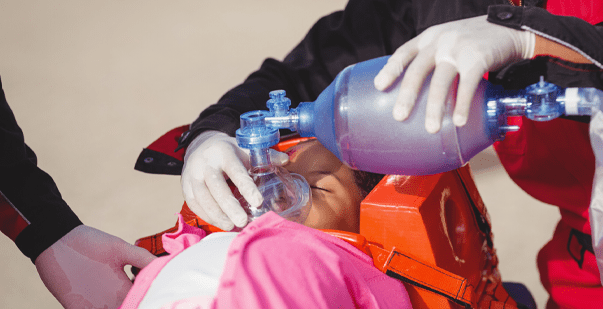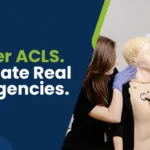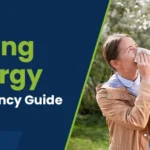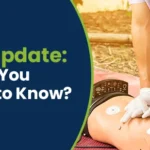Breathing is the lifeline for every living creature. However, certain situations or medical conditions could cause respiratory arrest, making breathing difficult. When the breathing completely stops, the situation is called a respiratory arrest. While it may sound similar to a cardiac arrest, the two differ. In 2022, close to 791,200 people visited the emergency departments for respiratory arrest from Chronic Obstructive Pulmonary Diseases. Many of these patients never see the light of day.
However, with the proper knowledge, every family member and bystander can help a person suffering from respiratory arrest. Learn more about respiratory arrest, distress, and its relation to cardiac arrest.
Master ACLS Now
Get ACLS certified with confidence
What is Respiratory Arrest?
Respiratory arrest refers to the sudden cessation of breathing. It occurs when a person stops breathing or cannot breathe adequately to sustain life. Unlike a heart attack, which involves the heart’s pumping action, respiratory arrest primarily involves the failure of the respiratory system.
Cardiac Arrest Vs. Respiratory Arrest
While one may lead to another, cardiac and respiratory arrest have the following differences.
| Aspect | Cardiac Arrest | Respiratory Arrest |
| Definition | Sudden stop of the heart’s pumping action. | Cessation of breathing; the person stops breathing or is unable to breathe effectively. |
| Causes | Arrhythmias, heart attack, electrical malfunctions. | Airway obstruction, respiratory muscle failure, severe respiratory conditions. |
| Signs and Symptoms | Unresponsiveness, absence of breathing, no pulse. | Cessation of breathing, lack of chest movement. |
| Immediate Response | CPR, followed by use of Automated External Defibrillator (AED). | Rescue breathing, clearing airway obstructions, basic life support measures. |
| Treatment Focus | Restarting the heart’s pumping action. | Respiratory arrest treatment includes restoring and maintaining breathing; oxygenation of the body. |
| Emergency Response | Urgent and immediate. | Urgent, but the timeline for intervention may allow for a slightly longer response time compared to cardiac arrest. |
| Outcome Importance | Rapid intervention is critical for a positive outcome. | Rapid intervention is crucial to prevent oxygen deprivation and potential brain damage. |
Understanding cardiac and respiratory arrest differences is crucial for effective emergency response. While both require urgent attention, the focus of intervention varies based on the affected system — the heart or the respiratory system.
What Causes Respiratory Arrest?
Respiratory arrest occurs due to various factors that compromise the ability to breathe effectively. Here are four common causes:
- Airway Obstruction: Blockage of the airway, often due to choking on food or a foreign object, can lead to a lack of airflow, resulting in respiratory arrest.
- Drug Overdose: Certain drugs can lower the pace of breathing. Drug overdoses can lead to respiratory arrest.
- Severe Respiratory Conditions: Chronic conditions like asthma, chronic obstructive pulmonary disease (COPD), or pneumonia can escalate, causing a significant reduction in airflow and respiratory arrest.
- Cardiac Arrest: In some cases, cardiac arrest (heart-stopping) can lead to respiratory arrest. The lack of blood circulation affects oxygen delivery to the body, impacting the respiratory system.
Prompt recognition and intervention are crucial when respiratory arrest occurs, and appropriate life-saving measures, such as CPR, may be necessary to restore breathing until professional medical help arrives.
What is Respiratory distress?
Respiratory distress refers to a condition where an individual experiences difficulty breathing. You will notice labored, rapid, or abnormal breathing patterns. It could also point toward an underlying heart issue.
Respiratory Arrest Vs. Respiratory Distress
A seasoned healthcare professional would know the following differences between respiratory distress and arrest.
| Aspect | Respiratory Arrest | Respiratory Distress |
| Definition | Cessation of breathing; no breaths. | Difficulty breathing; labored or abnormal breathing. |
| Causes | Airway obstruction, respiratory muscle failure, etc. | Asthma, pneumonia, allergic reactions, trauma, etc. |
| Signs and Symptoms | Absence of breathing, unresponsiveness. | Rapid breathing, shortness of breath, use of accessory muscles, cyanosis (bluish skin). |
| Immediate Response | Rescue breathing, CPR. | Administering medications (if prescribed), providing oxygen, addressing underlying causes. |
| Treatment Focus | Restarting and maintaining breathing. | Alleviating the cause, improving breathing efficiency. |
| Emergency Response | Urgent and immediate. | Urgent, but the timeline for intervention may allow for slightly longer response time. |
| Outcome Importance | Rapid intervention is crucial for a positive outcome. | Swift intervention is essential to prevent respiratory failure and improve oxygenation. |
Understanding the differences between respiratory arrest and respiratory distress is vital for appropriate and timely emergency response. While respiratory arrest demands immediate attention to restore breathing, respiratory distress requires prompt intervention to address the underlying cause and support effective breathing.
Read More: Oxygen Therapy in ACLS
What is Respiratory failure?
Respiratory failure is when the lungs fail to maintain adequate oxygenation of the blood and eliminate carbon dioxide, resulting in an imbalance of gasses in the body. It is a critical condition that can occur gradually or suddenly.
Signs of Respiratory Failure Vs. Respiratory Distress
While both these may seem alike, respiratory failure and distress have many differences. Here are differences in signs of respiratory failure and respiratory distress:
| Signs | Respiratory Distress | Respiratory Failure |
| Respiratory Rate | Increased | Variable (may be increased, normal, or decreased) |
| Accessory Muscles | Engaged | Increased use of accessory muscles |
| Skin Color | Present; bluish tint | Pronounced; severe bluish discoloration |
| Breath Sounds | Abnormal (wheezing, stridor) | May be faint or absent |
| Retractions | Present (between ribs or neck) | May be present in severe cases |
| Nasal Flaring | Yes | May occur in severe cases |
| Mental Status | Anxiety, confusion, restlessness | Altered mental status, decreased consciousness |
| Oxygen Saturation | May be decreased but not severely low | Significant decrease |
| Level of Consciousness | Generally maintained | Progressive decline |
| Breathing Pattern | Rapid and shallow; increased effort | May be rapid, slow, or absent |
| Blood Gas Levels | May show signs of hypoxemia | May include hypoxemia, hypocapnia, or hypercapnia |
| Cardiovascular Effects | Generally compensated; stable BP | Signs of inadequate perfusion; may include hypotension |
Types of Respiratory Arrest
Respiratory arrest is a medical emergency identified by the cessation of breathing. While there may not be distinct “types” of respiratory arrest, it can manifest in various ways based on the underlying cause. Here are key points related to manifestations or contributing factors:
- Complete Cessation: Respiratory arrest may involve no airflow into the lungs.
- Inadequate Breathing: In some cases, respiratory arrest may manifest as inadequate breathing, where the breaths taken are insufficient to maintain oxygen levels.
- Sudden Onset: Respiratory arrest can occur suddenly, especially in cases of airway obstruction, drug overdose, or certain medical conditions.
- Gradual Onset: Certain chronic conditions or diseases can lead to a gradual decline in respiratory function, eventually culminating in respiratory arrest.
- Related to Cardiac Arrest: Respiratory arrest may coincide with or be a consequence of cardiac arrest, where the heart stops beating. The two often go hand in hand in critical situations.
- Neuromuscular Causes: Conditions affecting the nerves or muscles involved in breathing, such as neuromuscular disorders, can lead to respiratory muscle failure and arrest.
Understanding the nuances of respiratory arrest is crucial for prompt recognition and appropriate intervention. In all cases, immediate medical attention and life-saving measures, such as CPR, may be necessary to restore breathing and oxygenate the body.
How to Manage a Respiratory Event Using ACLS
ACLS (Advanced Cardiovascular Life Support) is a set of medical techniques for the urgent treatment of heart-related issues and other life-threatening medical emergencies. While ACLS primarily focuses on cardiac events, it also includes elements to manage respiratory distress and arrest. Here is a general guide on managing a respiratory event using ACLS:
- Initial Assessment: Ensure scene safety and assess the patient’s responsiveness. If unresponsive, activate the emergency response system.
- Airway Management: Open the airway and assess breathing. If not breathing or breathing inadequately, initiate rescue breathing.
- Ventilation Support: Provide ventilatory support with a bag-mask device or advanced airway (endotracheal tube or supraglottic airway).
- Oxygen Administration: Administer high-flow oxygen to optimize oxygenation.
- Identification of Underlying Causes: Identify and treat reversible causes of respiratory distress or arrest, such as pneumothorax, pulmonary embolism, or severe electrolyte imbalances.
- Medication Administration: Administer medications as indicated, such as bronchodilators for obstructive respiratory conditions or epinephrine for severe allergic reactions.
- Advanced Airway Management: Consider advanced airway management techniques, such as endotracheal intubation or supraglottic airway placement, if the patient’s condition deteriorates.
- Continuous Monitoring: Continuously monitor vital signs, ECG, and other relevant parameters.
- Reassessment and Adjustments: Regularly reassess the patient’s response to interventions and make adjustments as needed.
Read More: ACLS skills for Medical Emergencies
Conclusion
It’s important to note that ACLS protocols may vary, and healthcare providers should follow the specific guidelines and algorithm. Immediate and effective management is crucial in respiratory arrest. Any healthcare professionals trained in ACLS can provide advanced interventions to improve patient outcomes and save more lives.







